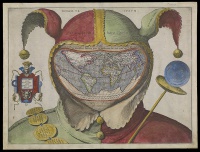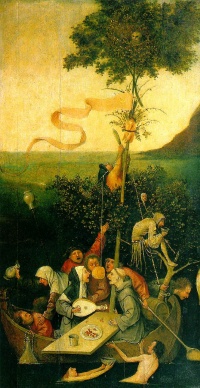Jester
From The Art and Popular Culture Encyclopedia
| Revision as of 06:23, 10 July 2014 Jahsonic (Talk | contribs) ← Previous diff |
Current revision Jahsonic (Talk | contribs) |
||
| Line 1: | Line 1: | ||
| - | [[Image:Ship of Fools by Jheronimus Bosch.jpg|thumb|right|200px|''[[Ship of Fools (painting)|Ship of Fools]]'' by [[Hieronymus Bosch]]]] | + | [[Image:Fool's Cap World Map by anonymous.jpg|thumb|left|200px|''[[Fool's Cap World Map]]'' (c. 1590s) by anonymous]][[Image:Ship of Fools by Jheronimus Bosch.jpg|thumb|right|200px|''[[Ship of Fools (painting)|Ship of Fools]]'' by Hieronymus Bosch]] |
| {{Template}} | {{Template}} | ||
| A '''jester''', '''[[joker]]''', '''[[fool]]''' or '''[[buffoon]]''', is a specific type of [[entertainer]] mostly (but not always) associated with the [[Middle Ages]]. Jesters typically wore brightly colored clothing in a [[motley]] pattern. Their hats, sometimes called the cap ’n bells, cockscomb (obsolete [[coxcomb]]), were especially distinctive; made of cloth, they were floppy with three points (liliripes) each of which had a [[jingle bell]] at the end. The three points of the hat represent the asses' ears and tail worn by jesters in earlier times. Other things distinctive about the jester were his incessant laughter and his mock [[scepter]], known as a bauble or maharoof. | A '''jester''', '''[[joker]]''', '''[[fool]]''' or '''[[buffoon]]''', is a specific type of [[entertainer]] mostly (but not always) associated with the [[Middle Ages]]. Jesters typically wore brightly colored clothing in a [[motley]] pattern. Their hats, sometimes called the cap ’n bells, cockscomb (obsolete [[coxcomb]]), were especially distinctive; made of cloth, they were floppy with three points (liliripes) each of which had a [[jingle bell]] at the end. The three points of the hat represent the asses' ears and tail worn by jesters in earlier times. Other things distinctive about the jester were his incessant laughter and his mock [[scepter]], known as a bauble or maharoof. | ||
| ==Etymology== | ==Etymology== | ||
| From Middle English ''[[geste]]'' (“idle tale”), from Old French ''geste'' (“acts, exploits”), from Latin ''[[gesta]]'' (“acts, deeds”) | From Middle English ''[[geste]]'' (“idle tale”), from Old French ''geste'' (“acts, exploits”), from Latin ''[[gesta]]'' (“acts, deeds”) | ||
| + | ==Notable Jesters== | ||
| + | ===Historical=== | ||
| + | * [[Stańczyk]] (c. 1480–1560), Polish jester | ||
| + | * [[William Sommers]] (died 1560), jester of [[Henry VIII of England]] | ||
| + | * [[Chicot]] (c. 1540–1591), jester of [[Henry III of France]] | ||
| + | * [[Archibald Armstrong]] (died 1672), jester of [[James I of England]] | ||
| + | * [[Jeffrey Hudson]] (1619–c. 1682), "court dwarf" of [[Henrietta Maria of France]] | ||
| + | * [[Jamie Fleeman]] (1713–1778), the Laird of Udny's Fool | ||
| + | * [[Perkeo of Heidelberg]] 18th Century, jester of Prince [[Charles III Philip, Elector Palatine]] | ||
| + | |||
| + | ===Modern Day Jesters=== | ||
| + | * [[Jesse Bogdonoff]] (b. 1955), court jester and financial advisor of [[Taufa'ahau Tupou IV]] | ||
| ==See also== | ==See also== | ||
| Line 18: | Line 30: | ||
| * [[Marotte]], the jester's bauble, or rod of office | * [[Marotte]], the jester's bauble, or rod of office | ||
| * [[Master of the Revels]] | * [[Master of the Revels]] | ||
| + | * [[Seriocomic]] | ||
| * [[Skomorokh]] | * [[Skomorokh]] | ||
| * [[Triboulet]] | * [[Triboulet]] | ||
Current revision


|
Related e |
|
Featured: |
A jester, joker, fool or buffoon, is a specific type of entertainer mostly (but not always) associated with the Middle Ages. Jesters typically wore brightly colored clothing in a motley pattern. Their hats, sometimes called the cap ’n bells, cockscomb (obsolete coxcomb), were especially distinctive; made of cloth, they were floppy with three points (liliripes) each of which had a jingle bell at the end. The three points of the hat represent the asses' ears and tail worn by jesters in earlier times. Other things distinctive about the jester were his incessant laughter and his mock scepter, known as a bauble or maharoof.
Contents |
Etymology
From Middle English geste (“idle tale”), from Old French geste (“acts, exploits”), from Latin gesta (“acts, deeds”)
Notable Jesters
Historical
- Stańczyk (c. 1480–1560), Polish jester
- William Sommers (died 1560), jester of Henry VIII of England
- Chicot (c. 1540–1591), jester of Henry III of France
- Archibald Armstrong (died 1672), jester of James I of England
- Jeffrey Hudson (1619–c. 1682), "court dwarf" of Henrietta Maria of France
- Jamie Fleeman (1713–1778), the Laird of Udny's Fool
- Perkeo of Heidelberg 18th Century, jester of Prince Charles III Philip, Elector Palatine
Modern Day Jesters
- Jesse Bogdonoff (b. 1955), court jester and financial advisor of Taufa'ahau Tupou IV
See also
- Basil Fool for Christ
- Bouffon
- Clown society
- Foolishness for Christ
- Harlequin
- Itinerant poet
- Jest
- Jest book
- Jester's privilege
- List of jesters
- Marotte, the jester's bauble, or rod of office
- Master of the Revels
- Seriocomic
- Skomorokh
- Triboulet
- Trickster

